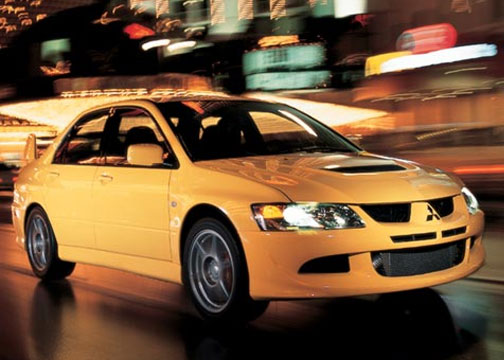2003 MITSUBISHI LANCER EVOLUTION - Review
 |
SEE ALSO: Mitsubushi Buyer's Guide
THE CROTCH ROCKET WITH 4-WHEELS
By Marc J. Rauch, Exec. VP & Co-Publisher
The long awaited and highly touted Evo finally made landfall in North America, and itís everything Mitsubishi said it would be. However, I must admit, it took two different tests drives for me to find that out.
The first test drive was during the press introduction at Firebird International Raceway in Phoenix. Iím not sure if it was because of the limited piece of track that we drove on, or if it was because we had been test driving another Mitsubishi vehicle earlier that same day on regular roads, but I didnít leave Phoenix feeling uplifted by the experience. Yes, the Evo was fast off the mark. And yes, it was sporty and nimble in the curves. It just wasnít the evolution in driving that I had expected.
Fortunately, I didnít have to wait too long to give the Evo another go. The second test took place in and around the Thunder Hill Raceway in Northern California. The occasion this time was the annual Western Automotive Journalists Media Day (media days, to be a bit more precise). With the open expanse and terrain diversity of both the public roads and Thunder Hillís track, I discovered what I didnít find in Phoenix: a totally thrilling and enjoyable experience. Whatís more, I was able to compare the Evo directly against Subaruís vaunted WRX STI.
Now I know that Subaruís specifications appear to make the WRX the superior vehicle, but I didnít personally get that feeling. While the WRX is very impressive, I was more wowed by the Evo. I thought the Evo came out of turns faster, that it was easier to control, and that it wasnít as herky-jerky in shifting. A comparison of the two vehicleís specifications may illustrate that my perception was wrong, but if this review is anything, itís just a statement of my driving impressions and not a scientific analysis (which, of course, Iím not qualified to give).
That having been said, my impression is that the Evo is a crotch rocket with 4-wheels. It has all the exhilaration of riding a motorcycle, with two additional wheels to keep you balanced. Although Lancer Evolution is new to the U.S., itís been on the streets of Japan since 1992. To compete in the FIA racing circuit, Mitsubishi had to build a minimum of 2,500 street versions of the Lancer Evolution for pubic sale. For our market, Mitsu initiated several changes and improvements. Among the improvements were to strengthen structural rigidity and optimize handling. Mitsubishi swapped lighter, aluminum for the Lancer sedan's steel suspension components, and the combination of MacPherson struts up front and a multi-link set-up in back is tuned closer to track performance levels.
The Evoís power train delivers maximum power from a rather minimum size. The DOHC 4-cylinder motor provides amazing results: 271 hp @ 6,500 rpm and 273 lb. ft. of torque @ 3,500 rpm. It utilizes an intercooled turbocharger, aluminum heads, and a number of internal refinements aimed at decreasing weight and increasing power and durability. Mitsubishi states that the Evo is capable of doing 0-60 mph in 5.0 seconds, a 13.8 second quarter mile, and a top end of 155 mph. Yeah, that seemed about right (donít tell my insurance company I said so).
The Evoís full-time, all wheel drive system distributes torque evenly between front and rear wheels. Evidently, this is why I found the carís handling to be so excellent.
Visually, the Evo looks as muscular as it drives: not in the sense of a classic 50ís or 60ís muscle car, more like a flexed bicep muscle. With its big rear optional wing, the Evo looks like it might go to warp 10 at any moment.
The inside is the only aspect of the Evo that could use some work. Similar to many of the other Mitsubishi models, the interior doesnít rise to the same levels that theyíve achieved everywhere else. Theyíre designed beautifully, well built and engineered, fast, fun, priced great, but the interiors are second cabin.
Mitsubishi hopes to sell between 5,000 and 6,500 Evos, but, the sales numbers are secondary to what they hope that the car will do for their overall image and brand recognition. It would seem to me that even with a somewhat pricey price tag that starts around $29,000; Mitsubishi should have a big success on its hands.


